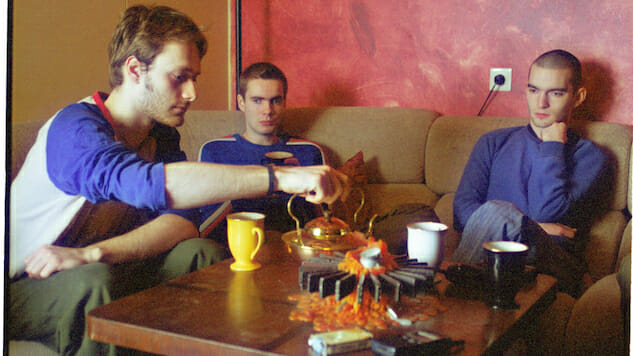Sigur Rós’ Former Keyboardist Tells the Story of Their Breakthrough Album, Ágætis byrjun, 20 Years Later
The Icelandic band has released a vinyl box set in celebration of the record’s 20th anniversary
Photo by Björg Jóna Sveins
“It is beautiful Steve,” says Anjelica Huston during the climax of Wes Anderson’s 2004 film, The Life Aquatic with Steve Zissou. For the first time since it killed Steve Zissou’s best friend, the entire crew finally sees the jaguar shark, the animal they’ve been hunting for nearly the entire movie.
“Yeah, it’s pretty good isn’t it?” replies the titular character, played by Bill Murray.
Those two simple lines, both filled with a sense of wonder, could very easily describe the song that was playing throughout the scene, “Starálfur,” by then-rising Icelandic band Sigur Rós. With gorgeous sweeping strings, an otherworldly sounding piano and lead singer Jónsi’s stunning falsetto, it’s not surprising that the song—despite it being sung in Icelandic, not English—fits so perfectly in such a beautiful scene. It’s so overwhelmingly pretty that eight years later, in 2012, a deaf man who successfully tried new hearing aids asked Reddit, “I can hear music for the first time ever, what should I listen to?” and he quickly listed “Starálfur” as one of his favorites, just a day after discovering music et al.
When zoning out to Sigur Rós, it’s easy to hear why they’ve been playing some of the world’s grandest theaters and popping up in the biggest films and TV shows for the past two decades: Each song takes the listener on an emotional journey, sometimes a haunting one and other times a beautiful one. But the backstory of “Starálfur”—and Ágætis byrjun as a whole—is a bit surprising. How could this album, which has recently celebrated its 20th anniversary and is today (July 26) being released as a vinyl box set complete with demos and a live performance from 1999, have been made by a group of struggling musicians, all in their early 20s?
“There was a moment where we went, ‘Wow, this is some shit we’re doing. This is going to go somewhere, not just in Iceland,’ explains Kjartan Sveinsson, Sigur Rós’ former keyboardist, string arranger and multi-instrumentalist. “There was this feeling of doing something important. I think the confidence came from there.”
Pretty confident for a band whose first album famously sold only 300 copies, huh?
“Basically, it was just us being so confident and invisible and immortal,” he adds. “We would just go and do things without any hesitation, and we were lucky enough to have a record company who were actually willing to pay for the album. It was kind of expensive at that time for an Icelandic album.”
And that investment by Icelandic label Smekkleysa eventually paid off. While it would take more than a year for it to hit stores in the U.K. and an extra nine months in the U.S., the record benefitted from a word-of-mouth campaign, leading to rapturous critical acclaim. Then, suddenly, the band found themselves opening for Godspeed You! Black Emperor and, later, Radiohead in 2000. By 2001, three of their songs were prominently featured in Vanilla Sky, one of the biggest movies of that year.
“For us, it was like ‘Of course we’re supporting Radiohead. They really should be supporting us, but what the heck,’ Sveinsson remembers. “It was a ridiculous attitude. Who else would be supporting Radiohead? That kind of insanely arrogant confidence going on, and when you look back, it’s like ‘Whoa, that’s crazy!’ Being at that age, around 20, and you’ve just become an adult—you want to go as far as you can. I always think it’s so amazing to see young people who are totally in their element doing exactly what they want. This was an amazing thing.”
The sky was the limit for the Icelandic band, a group of talented musicians willing to experiment with new software and unique instruments. They bought the first quality SSL desk in Iceland, a high-end mixing console, and secured their own small studio. Inside, they’d play around with PC software, which they used to manipulate strings, reverse the recordings and just play around with.
-

-

-

-

-

-

-

-

-

-

-

-

-

-

-

-

-

-

-

-

-

-

-

-

-

-

-

-

-

-

-

-

-

-

-

-

-

-

-

-








































